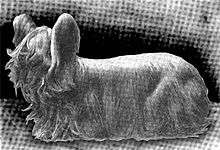List of Scottish breeds
This is a list of domesticated animal breeds originating from Scotland. To be considered domesticated, a population of animals must have their behaviour, life cycle, or physiology systemically altered as a result of being under human control for many generations.[1]
Scotland has produced some of the longest established breeds of domesticated animals still in existence. There are 37 individual breeds of animals from Scotland still in existence and three extinct breeds. The Soay Sheep has prehistoric origins, and the Galloway breed of beef cattle dates back several hundred years. New breeds have also been developed more recently in Scotland, such as the Scottish Fold cat, which dates from 1961.[2]
The North Ronaldsay Sheep is a most unusual breed, subsisting largely on a diet of seaweed,[3] and the Boreray is the UK's rarest sheep, having been listed as "Category 2: Endangered" by the Rare Breeds Survival Trust.[4] Some breeds, such as the Shetland Pony and the Border Collie are well known throughout much of the Western world, whilst others such as the Scots Dumpy chicken are little-known, even at home. Nine breeds of dog have Scottish origins, including five terrier breeds.[5] Indeed the relative isolation of many of Scotland's numerous islands has led to a preponderance of breeds from these places being represented. Various breeds are now extinct, including the Grice, an archaic and somewhat aggressive pig.[6]
Extant breeds
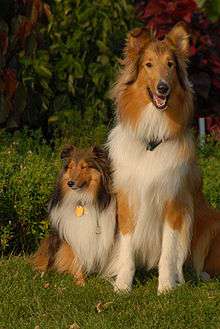
| Breed | Photo | Species | Date of Origin | Location of Origin | Status |
|---|---|---|---|---|---|
| Scottish Fold |  |
Cat | 1961 | Coupar Angus | Rare[2] |
| Aberdeen Angus | 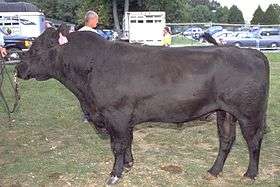 |
Cattle | 18th century | Angus | Common[7] |
| Ayrshire Cattle | Cattle | prior to 1800 | Ayrshire | Common[8][9] | |
| Belted Galloway | 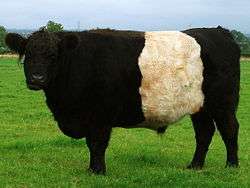 |
Cattle | 17–18th century | Galloway | Rare[10] |
| Galloway | 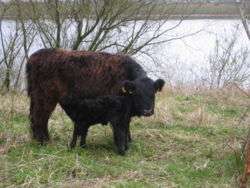 |
Cattle | 700–1100 | Galloway | Established worldwide[11] |
| Highland Cattle | Cattle | Pre 19th century | West Highlands | Established worldwide[12] | |
| Luing Cattle |  |
Cattle | Post 1947 | Luing | "Firmly established"[13] |
| Shetland Cattle |  |
Cattle | 700–1100 | Shetland | At risk[14] |
| Scots Dumpy | Chicken | 11th century | Highlands | Priority;[15] Rare[16] | |
| Scots Grey | 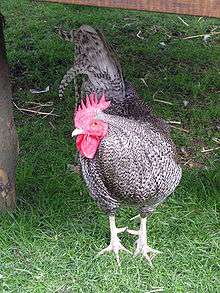 |
Chicken | 16th century | Lanarkshire | Priority;[15] Rare[17] |
| Bearded Collie | 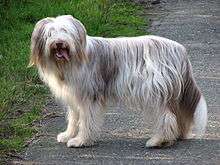 |
Dog | 16th century? | Scottish Borders? | Common[18] |
| Border Collie |  |
Dog | pre 19th century | Possibly Scottish Borders | Common[19] |
| Border Terrier | 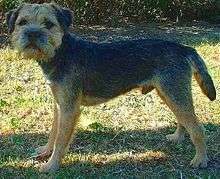 |
Dog | c. 1790 | Scottish Borders | Common[20] |
| Cairn Terrier | 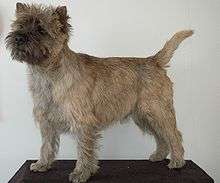 |
Dog | 16th century–19th century. | Skye | Common[21] |
| Dandie Dinmont |  |
Dog | mid 18th century or before | Skye and Scottish Borders | Rare[21][22] |
| Golden Retriever | 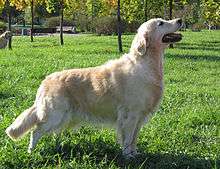 |
Dog | 19th century | Glen Affric | Common[23] |
| Gordon Setter | Dog | 1820s | Moray | Bred in UK and US[24] | |
| Rough Collie and Smooth Collie |  |
Dog | 19th century | England, partly using working Collies from Scotland. | Common[25] |
| Scottish Terrier or Scottie | 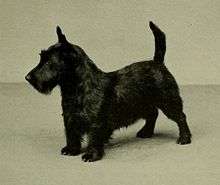 |
Dog | 16th century–19th century | Skye | Common[21][26] |
| Scottish Deerhound | 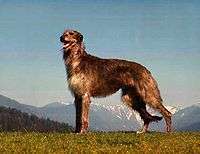 |
Dog | as a purebreed from early 19th century | Probably the Highlands | Common |
| Shetland Sheepdog or Sheltie | 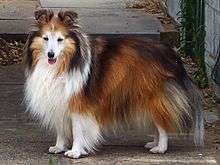 |
Dog | 1700 | England, partly using shepherd dogs from Shetland of now extinct type. | [27] |
| Skye Terrier | 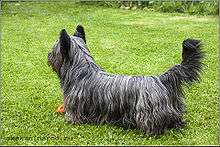 |
Dog | pre 1588 | Skye | Vulnerable Native Breed[21][28][29] |
| West Highland White Terrier or Westie | 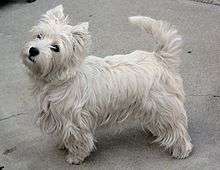 |
Dog | mid 19th century | Skye & Argyll | Common[21] |
| Shetland Goose | Goose | ? | Shetland | UK and US - Priority;[15] Critical[30] | |
| Clydesdale | 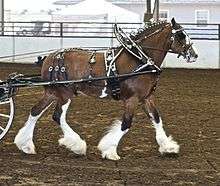 |
Horse | mid 18th century | Clydesdale | At Risk[31] |
| Eriskay Pony |  |
Horse | Hebrides | Critical[32][33] | |
| Highland Pony | 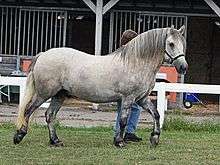 |
Horse | 16th century | Highlands and Islands | At Risk[34][35][36] |
| Shetland Pony |  |
Horse | "For over 2000 years and probably much longer".[37][38] | Shetland | Common[37][39] |
| Boreray or Hebridean Blackface | 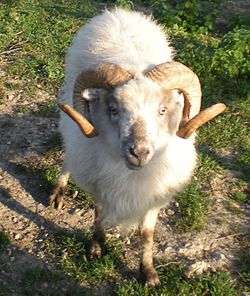 |
Sheep | 1930s | St Kilda, Scotland | Critical[40] |
| Castlemilk Moorit | 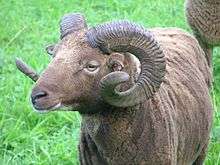 |
Sheep | 1900s | Dumfriesshire, from more ancient Scottish and other breeds including Soay and Shetland. | Critical[41][42] |
| Cheviot | 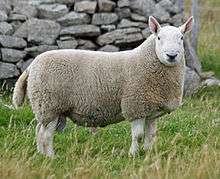 |
Sheep | 14th century or earlier | Scottish Borders | Common[43] |
| Hebridean Sheep | 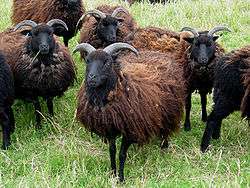 |
Sheep | 19th Century (Iron Age) | Cumbria, probably from sheep from the Hebrides | Rare[44] |
| North Country Cheviot |  |
Sheep | 18th century | Cheviot Hills, Caithness, Sutherland | UK and North America[45] |
| North Ronaldsay Sheep | 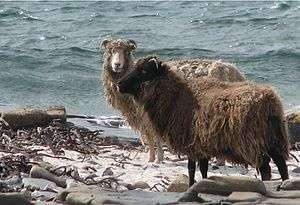 |
Sheep | Iron Age | North Ronaldsay | Rare[3][46] |
| Scottish Blackface |  |
Sheep | 16th century?[47][48] | Scottish Borders | Common[47] |
| Shetland Sheep | 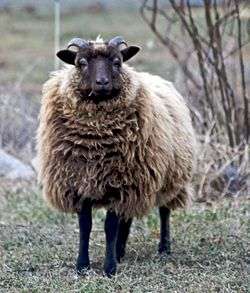 |
Sheep | Iron Age | Shetland | UK and North America[49] |
| Soay Sheep |  |
Sheep | Neolithic or Bronze Age | Soay, St Kilda | Rare[50][4] |
Extinct breeds
Prior to their demise, the Paisley Terrier contributed to the bloodline of the Yorkshire Terrier and the Scottish Tan Face to the Boreray sheep. Although Galloway Ponies were praised by Gervaise Markham in the 17th century for their "fine shape, easie pace, pure metall and infinit toughness", true to form Samuel Johnson described them as "common hackneys".[51] It shares its origins with the still extant Fell Pony. A model of the Grice, whose habit of attacking lambs cannot have aided its survival, was recreated by a taxidermist in 2006.[6]
| Breed | Species | Date of Origin | Location of Origin | Date of extinction |
|---|---|---|---|---|
| Paisley Terrier or Clydesdale Terrier | Dog | 19th century | Paisley, Clyde Valley | 20th century[52] |
| Galloway Pony | Horse | 16th century or earlier | Galloway | post 1901[51] |
| Grice | Pig | Unknown | Highlands and Islands (also Ireland) | c. 1930[6] |
| Scottish Dunface or Old Scottish Shortwool | Sheep | Iron Age | Highlands and Islands (previously British Isles) | late 19th century[53] (Survives as Shetland, Boreray, North Ronaldsay, Hebridean.) |
See also
References
- ↑ Zeder MA (2015). "Core questions in domestication Research". Proceedings of the National Academy of Sciences of the United States of America. 112 (11): 3191–8. PMC 4371924
 . PMID 25713127. doi:10.1073/pnas.1501711112.
. PMID 25713127. doi:10.1073/pnas.1501711112. - 1 2 "Scottish Fold Cat Information". Pet Finder. Retrieved 14 November 2015.
- 1 2 "North Ronaldsay". Sheep Breeds. Seven Sisters Sheep Centre. Retrieved 23 April 2009.
- 1 2 "RBST Watchlist". Retrieved 8 November 2015.
- ↑ "Dogs from Scotland". InfoDogs. Retrieved 14 November 2015.
- 1 2 3 "Extinct Island Pig Spotted Again". BBC News. 17 November 2006. Retrieved 1 January 2007.
- ↑ "Angus" Oklahoma State University. Retrieved 21 July 2009.
- ↑ "The Breed" Ayrshire Cattle Society. Retrieved 20 July 2009.
- ↑ "Why Ayrshires" US Ayrshire Breeders' Association. Retrieved 20 July 2009.
- ↑ "Belted Galloway" Oklahoma State University. Retrieved 20 July 2009.
- ↑ "Galloway History" Archived 14 October 2008 at the Wayback Machine. Galloway Cattle Society of New Zealand. Retrieved 20 July 2009.
- ↑ "The Highland Breed" Highland Cattle Society. Retrieved 20 July 2009.
- ↑ "History of the Breed" Luing Cattle Society. Retrieved 20 July 2009.
- ↑ "Home" Shetland Cattle Breeders Association. Retrieved 20 July 2009.
- 1 2 3 Watchlist 2017–18. Stoneleigh Park, Warwickshire: Rare Breeds Survival Trust. Accessed May 2017.
- ↑ "Scots Dumpy chickens at Kintaline Farm" scotsdumpy.co.uk. Retrieved 20 July 2009.
- ↑ " Scots Grey Hens at Kintaline Farm" scotsgrey.co.uk Retrieved 20 July 2009.
- ↑ "About the Breed" The Friendly Beardie Club. Retrieved 21 July 2009.
- ↑ "Collie breed history barkbytes.com. Retrieved 21 July 2009.
- ↑ "History of the Border Terrier" Archived 23 July 2014 at the Wayback Machine. Oberlin University. Retrieved 21 July 2009.
- 1 2 3 4 5 Initial grouping of several of the highland terriers (including the Scottie) under the generic name Skye terriers has caused some confusion in the breed’s lineage. There is much disagreement over whether the Skye terriers mentioned in early 16th century records actually descended from forerunners of the Scottie or vice versa. See Choosing a Scottish Terrier" Petplace.com. Retrieved 20 July 2009.
- ↑ "Dandie Dinmont Terrier History". Caledonian Dandie Dinmont Terrier Club. Archived from the original on 10 September 2009. Retrieved 21 July 2009.
- ↑ "Golden Retrievers: History" K9web.com. Retrieved on 30 November 2007.
- ↑ "About Gordon Setters" Gordon Setter Cub of America. Retrieved 20 July 2009.
- ↑ "History of the Rough Collie" collienet.com. Retrieved 21 July 2009.
- ↑ "Scottish Terrier" Britanica. Retrieved 20 July 2009.
- ↑ "Endemic Vertebrates of Shetland" nature-shetland.co.uk. Retrieved 20 July 2009. This source suggests that this is "a debatable breed, the Kennel Club variety probably differing significantly from the dogs that were used in Shetland in the past".
- ↑ Threlfall, Sine "Breed History" Skye Terrier Club Retrieved 20 July 2009.
- ↑ Savill, Richard (5 July 2006) "Skye Seven raise hope for breed's survival" The Telegraph. Retrieved 20 July 2009.
- ↑ "Shetland Goose" American Livestock Breeds Conservancy. Retrieved 20 July 2009.
- ↑ "Breed History" Clydesdale Horse Society. Retrieved 20 July 2009.
- ↑ "Eriskay Pony". Breeds of Livestock. Oklahoma State University. Archived from the original on 6 December 2008. Retrieved 19 March 2009.
- ↑ "Watchlist: Eriskay" Rare Breeds Survival Trust. Retrieved 20 July 2009.
- ↑ "History of Highland Ponies" Strathspey Highland Ponies/freespace.virgin.net. Retrieved 20 July 2009.
- ↑ "Highland Pony" mahalo.com. Retrieved 20 July 2009.
- ↑ Both sources state that fossil remains of the ancestors of the modern breed have been found dating from "60,000 BC" prior to the last Ice Age.
- 1 2 "Breed History" Archived 2 October 2011 at the Wayback Machine. Shetland Pony Studbook Society. Retrieved 20 July 2009.
- ↑ According to equine-world.co.uk "The first written record of the Shetland pony was in 1603 in the Court Books of Shetland."
- ↑ "Shetland Pony" Equine World. Retrieved 20 July 2009.
- ↑ "Watchlist: Boreray" Rare Breeds Survival Trust. Retrieved 20 July 2009. This categorisation indicates that fewer than 300 individuals are known to exist.
- ↑ "Castlemilk Moorit". Breeds of Livestock. Oklahoma State University Dept. of Animal Science. Retrieved 27 January 2008.
- ↑ "Castlemilk Description". Castlemilk Moorit Sheep Society. Retrieved 7 April 2009.
- ↑ "Cheviot". Breeds of Livestock. Oklahoma State University, Dept. of Animals Science. Retrieved 15 April 2009.
- ↑ "History of the Breed". Hebridean Sheep Society. Retrieved 20 July 2009. The breed is sometimes referred to as "St. Kilda Sheep", although it has no specific connection with the archipelago.
- ↑ "North Country Cheviot". Breeds of Livestock. Oklahoma State University, Dept. of Animal Science. Retrieved 6 April 2009.
- ↑ "A historic Introduction". The Native Sheep of North Ronaldsay. Sheep-Isle. Retrieved 23 April 2009.
- 1 2 "Scottish Blackface" sheep101.info/breedsS. Retrieved 20 July 2009.
- ↑ According to sheep101.info/breedsS "there is a tradition that they came from a Spanish ship wrecked during the northward flight of [the] Armada in 1588."
- ↑ "Shetland". Sheep Breeds - S-St. Sheep101.info. Retrieved 1 May 2009.
- ↑ "A Thumbnail History Of The Soay Sheep Of St. Kilda" Southern Oregon Soay Sheep Farms. Retrieved 20 July 2009.
- 1 2 "Galloways and Fell Galloways" The Fell Pony Museum. Retrieved 21 July 2009.
- ↑ Bailey, Susan (24 January 2008) "The Evolution Of The Yorkshire Terrier" articlealley.com. Retrieved 21 July 2009. This source suggest the Paisley and Clydesdale were two distinct breeds at one time.
- ↑ Culley, George (1807) Observations on Livestock London. Wilkie, Robinson et al. pp 146, 160–161. Retrieved 7 July 2010.
